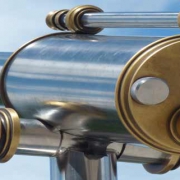The end of diesel
This article was written in summer 2015, before the break of the VW scandal as it was published in NGV. I just forgot to publish it here so far but don't want to alter the original article so - enjoy.
Imagine a world without diesel. It has been the backbone of modern logistics for as long as almost anyone on this planet can think. Most heavy-duty vehicles are run on it as it provides great endurance and torque to do even the hardest labor.
Take diesel out of our lives and many things we take for granted right now will just not be available anymore. Modern logistics would stop in its tracks, construction sites would grind to a halt and many, real many homes would be without power as their generators would remain silent.
Few things in our lives are so invisible and yet so incredibly important as diesel is and yet – diesel will vanish from this planet mainly because it’s slowly killing us and it makes us mad.
Let’s get specific.
On September 1st, 2015 – the EURO 6 standard becomes mandatory for all newly registered vehicles in the European Union. The EURO 6 rule sets new lows for the emission of toxic Nitrogen Oxides (NOx) and Particulate Matter (PM). The new, allowable emissions limits are so low in fact that there is a lot of talk about “clean diesel engines” as it is mainly diesel that produces and emits those nasty substances in great bulk.
But no rule can be taken seriously without a proper verification regime. To check, if the limits are not only hollow promises that will, in the end, be no benefit to the environment and hence the people, the European Union has also instituted a rolling verification regime that will be able to stop driving vehicles and test their compliance with emission limits from September 1st 2017 right on the road.
Those rolling tests are perceived as a mortal threat to the vehicle building industry as those engine builders know fully well that the limits of Euro 6 cannot possibly be met by using existing technology whenever Diesel is used as a fuel.
So far, the industry thought they would be able to swindle their way through the limits by setting up carefully prepared tests in ultra-controlled conditions allowing them to comply with the new rules at least on paper and theoretically. However, rolling vehicles are not nearly as efficient in terms of emissions output as those test engines in the protected workshops and laboratories of the vehicle makers. The subterfuge would not hold.
Moreover, the new emissions limits have not been introduced to be met in fake conditions but to improve the daily lives of ordinary people who have to breathe those exhaust gases every day. And that’s not the case.
Industry representatives already concede that diesel exhaust gases cannot possibly be cleaned up to the standards required by modern emissions legislation. This is so because diesel is an extremely filthy bunch of different hydrocarbons and a very nasty polluter in the first place.
In preceding articles, I have likened the diesel engine to a rolling trash incinerator as diesel is petroleum trash in the first place. Diesel is the lowest distillate from the refining column. Below it only ranks the filthy residual fuels that ships still use today to scorch the ocean’s skies. Those fuels have rightfully been banned in most countries as they turn life in the vicinity of the polluter into a nightmare.
In North-Western Europe, Residual Fuels are also getting more or less banned as the first Environmental Control Area strict enough kicks in 2016.
Diesel is just marginally better. The real sweet cuts from oil refining are the light fractions of the barrel namely gasoline and naphtha. Better still are the gases from Butane up to the super clean Methane. But we will get there. This means that if Residual Fuels are banned on land and the sea in most of the developed world, diesel will be the stuff at the bottom and become the focal point for environmentalists. Not an enviable position.
If diesel is such nasty stuff, why has it been able to become the backbone of our logistics economy in the first place?
Easy answer. First, there is lots of it and second, the diesel engine produces great torque which is good if you want to haul heavy loads from one end of the country to the other or if you want to provide a boost to heavy construction or earth-moving equipment. The engine can be built a bit smaller than corresponding gasoline or even gas engines and hence fuel consumption goes down.
Diesel has falsely been the darling of environmentalists for a long time as those less thirsty engines promised less fuel per kilometer and hence fewer emissions. The calculation was made with the devil providing the templates as one liter of diesel produces much more of the real nasty stuff than its corresponding lighter fuel.
We have fought against the big, visible particles when in fact it’s the very small, Nanoparticles that are far more toxic and much more dangerous. Nano Particulate Matter cannot be compared to the soot we see from diesel engines as it goes straight into our bloodstreams, our brains, and our cells and it even alters our DNA.
Nature has not equipped us with any defenses against those new pathogens as they are entirely man-made. For clarity – we have been living with fine particulates since giant lizards roamed the planet and way before that. Fine desert dust, pollen, and much other natural stuff have been around since the dawn of time. But those particles are mountains compared to the real small diesel engine emissions.
Paradoxically, so-called clean diesel engines make the problem worse as higher temperatures and higher pressures produce much more of the ultra-fine stuff and much less of the bigger particles. This is a wanted effect as the bigger particles are outlawed by environmental protection legislation and the Nano-Matter is not yet.
This will change as green activists the world over start to find out that they have fallen onto the dirty side of the deal and are up in arms. How long until further reductions and new, even tighter rules come in?
Cleaning up diesel exhaust would require technologies that are not available today and if they were, they would make the diesel engine incredibly expensive. Besides, the engine would also become even more of a technology hog which would make it prone to frequent breakdowns which in turn fleet vehicle owners and operators dread like the devil dreads holy water.
If diesel cannot be made clean, but regulation requires us to go this clean, what are the solutions then? And if further, even stricter legislation pokes holes into this already virtually impossible arrangement, then everything goes off the rails real quick.
We are gas people in the end and methane does not produce the above-described nasty stuff in the first place – I am talking about those very toxic particles. Other emissions are so drastically reduced that cleaning the tiny rest down to EURO 6 standards and even cleaner is easy and cheap.
The shale gas revolution has bestowed a real rush for LNG and CNG as a fuel in North America. It fuels a technological revolution that makes the gas engine cheaper, better, and more reliable than diesel ever was. New environmental standards have killed the premium paid for gas vehicles as they come in ever greater numbers bringing their prices down and diesel gets ever more expensive because of all the tech that goes onto the tail end.
The curves will meet this year in theory and 2017 at the very latest and that will be the end of it.
One line in the movie Cinderella went like this: don’t see the world for what it is but for what it could be.
The difference between Cinderella and the fuels world is that Cinderella is a fairytale and magic is needed for the prince and the girl to live happily ever after. In the real fuels world, there is no magic necessary as all the ingredients for weaning us off diesel are already there.
One must only step back and see the entire picture.
Kiss your old diesel goodbye. You better board the LNG and CNG bandwagon – if you wanna live.


















Leave a Reply
Want to join the discussion?Feel free to contribute!